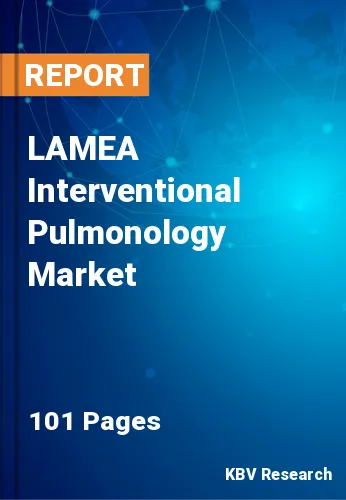The Latin America, Middle East and Africa Interventional Pulmonology Market would witness market growth of 12.5% CAGR during the forecast period (2023-2029).
Bronchial thermoplasty is a minimally invasive surgery that uses a catheter to deliver radiofrequency radiation to the bronchial wall. A bronchoscope is placed into the nasal cavity, and a thermoplasty catheter is pushed to the treatment site. The catheter is equipped with temperature sensors and four electrodes shaped like a basket. Bronchial thermoplasty is conducted over three weeks in three different sessions. Different portions of the bronchi are addressed for therapy in each setting, like the left lower lobe, and right lower lobe are managed in the initial and second settings, while the upper lobes are addressed in the third set.
Asthma is the most prevalent chronic disease, and bronchial thermoplasty is an innovative treatment. Asthma is a more prevalent chronic disease that increases with age among children. It is a complicated, inflammatory disease resulting from a genetic mutation or other environmental causes. With asthma, the airway muscles grow hypersensitive to allergens, resulting in inflammation of the muscular wall of the airway tract and a narrowing of the airway passage. Eventually, the inflammation causes a thickening of the smooth muscle of the airway tract, resulting in a restriction of airflow that impairs breathing. Albuterol, corticosteroids, and beta-agonists are administered via inhalers and nebulizers for the treatment of asthma.
Asthma is among the UAE's Department of Health's highest-priority public health concerns. The DOH's Asthma program aims to reduce asthma-related emergency department visits, hospitalizations, job and school absences, and, most importantly, mortality. This can be accomplished by improving the diagnosis and management of asthma in hospitals and clinics. The government's guidelines aim to enhance the diagnosis and treatment of adult asthma by primary care physicians, thereby helping to avoid asthma-related premature deaths. In addition, the increasing prevalence of asthma and ongoing research into its treatment will lead to increased use of bronchodilators, hence fostering market expansion.
The Brazil market dominated the LAMEA Interventional Pulmonology Market by Country in 2022, and would continue to be a dominant market till 2029; thereby, achieving a market value of $116.8 million by 2029. The Argentina market is experiencing a CAGR of 13.1% during (2023 - 2029). Additionally, The UAE market would display a CAGR of 12.2% during (2023 - 2029).
Based on Product, the market is segmented into Bronchoscopes, Electromagnetic Navigation Bronchoscopy System, Bronchial Thermoplasty Systems, Pleuroscopes, Respiratory Endotherapy Devices, Endobronchial Valves and Airway Stents & Pleural Catheters. Based on Indication, the market is segmented into Asthma, Lung Cancer, COPD, Tracheal & Bronchial Stenosis and Others. Based on End-user, the market is segmented into Hospitals, Ambulatory Surgical Centers, Diagnostic Centers, Specialty Clinics and Others. Based on countries, the market is segmented into Brazil, Argentina, UAE, Saudi Arabia, South Africa, Nigeria, and Rest of LAMEA.
Free Valuable Insights: The Worldwide Interventional Pulmonology Market is Projected to reach USD 5.9 Billion by 2029, at a CAGR of 6.9%
The market research report covers the analysis of key stake holders of the market. Key companies profiled in the report include Medtronic PLC, Boston Scientific Corporation, Becton, Dickinson and Company, Olympus Corporation, Fujifilm Holdings Corporation, ICU Medical, Inc. (Smiths Medical), HUGER Medical Instrument Co., Ltd, Cook Medical, Inc. (Cook Group), Clarus Medical LLC and Vygon SAS.
By Product
By Indication
By End-user
By Country
Our team of dedicated experts can provide you with attractive expansion opportunities for your business.

